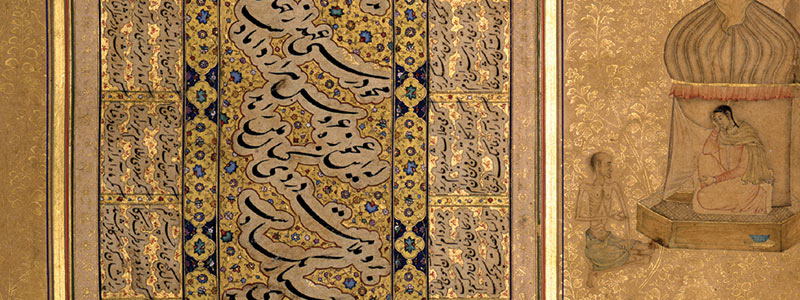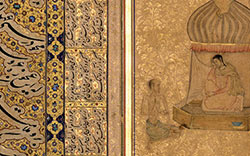Soltān ‘Ali, known as “Qeblat al-Kottāb” or “Beacon of Scribes,” was born in Mashhad in 1437 CE. The best source for his biography is a treatise named Ādāb-e Khatt (or “Etiquette of Calligraphy”), which he wrote in 1514 CE. It indicates that when he was seven years old his father died and that early on in life he began practicing calligraphy on his own. It goes on to explain that one day he happened to meet Mir Moflesi, who went on to teach him Arabic alphanumerology (abjad). With this, his interest in calligraphy increased until eventually he began disciplining himself through fasting and practice, writing calligraphy night and day. After reaching the age of twenty, his name began to gain relative fame in his native land until he eventually reached a point at which both Turkish and Tajik students came to study with him. The treatise Ādāb-e Khatt strangely neglects substantial parts of his biography that followed, including his eventual immigration to Herat and entrance into the court of Soltān Hosayn, as well as his acquaintance with Amir ‘Ali-Shir Navā’i and ‘Abd-al-Rahman Jāmi. From the dates on the earliest manuscripts he wrote in Herat, it appears that Soltān ‘Ali immigrated there sometime before the onset of the sultanate of Soltān Hosayn Bāyqarā (1468 CE), and remained there until returning permanently to Mashhad more than forty years later in 1506 CE. During his time in the court at Herat he busied himself with creating a considerable number of artistic works, resulting in his gaining great fame and renown. His extant works of calligraphy date from the years 1461 CE to 1515 CE. Considering the dates of his birth and death, this means that his writing life spanned from the ages of 29 to 85, though he was most active between 1490 CE and 1494 CE. All of this can be confidently posited due to the fact that out of the thirty-four works that carry his authentic signature, twenty bear the specific date of their writing.
In addition to the treatises cited in his extant biographies, his most important treatise is that mentioned above, Ādāb-e Khatt (one of which, in the handwriting of Soltān ‘Ali himself, is held in the National Public Library of Russia). This work was one of the most comprehensive and lyrical didactic treatises of the sixteenth century. Its short length (numbering at only about three hundred verses) ensured that it could be memorized easily, and could therefore be used as a mnemonic tool. Though in the treatise he does not present himself as the student of any master, his contemporaries recognize him as the student of Azhar Tabrizi. Soltān ‘Ali also taught many students, the most important of whom were Soltān Mohammad Khandān, Soltān Mohammad Nur, Zayn-al-Din Mahmud (Soltān ‘Ali’s son-in-law), ‘Abdi Nishāpuri, Mohammad Abrishami, Mohammad Qāsem Shadishāh, Mulānā Rostam ‘Ali, and ‘Alā-al-Din Mohammad Heravi. One of the difficulties in identifying the original works of Soltān ‘Ali is the similarity his name bears to a number of his contemporaries’. Because some works bear only the signature “Soltān ‘Ali” and lack the clarifying last name “Mashhadi,” identifying which of the Soltān ‘Alis who lived during the fifteenth and sixteenth centuries to whom the signature belongs is a persistent problem. The six calligraphers who have the same name are:
1 – Soltān ‘Ali Kāteb Esfahani
2 – Soltān ‘Ali Qāini (d. 1534 CE)
3 – Soltān ‘Ali Khawrazmi (d. 1513 CE)
4 – Soltān ‘Ali Shirāzi (15th-16th centuries CE)
5 – Soltān ‘Ali Ubahi
6 – Soltān ‘Ali Sabz-Mashhadi (d. circa late 15th CE)
When Soltān Hosayn passed away in 1505 CE, Soltān ‘Ali left the Herat sultanate and returned to his birthplace in Mashhad. After several years of suffering from illness he died in 1520 CE and was buried at the shrine of Imam Reza.




